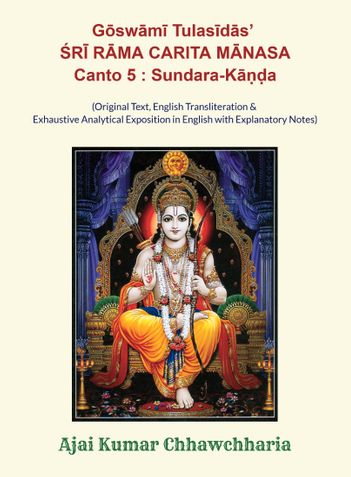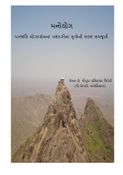Description
This Volume no. 8 continues with the English narration of the Story of Lord Ram as described in the devotional classic known as ‘Ram Charit Manas’ written by Goswami Tulsidas, from where we had left it in volume no. 7, i.e. the end of Canto 4, Kishkindha Kand.
The entire Book ‘Ram Charit Manas’ is divided into 7 Cantos, named Baal Kand, Ayodhya Kand, Aranya Kand, Kishkindha Kand, Sundar Kand, Lanka Kand, and Uttar Kand.
Hanuman made a giant leap across the ocean to land on the soil of the island of Lanka. After overpowering Lankini, the gatekeeper of the city, he entered the capital of the demon race in the darkness of the night, and searched for Sita from door to door, but failed to trace her. At dawn he met Vibhishan, who was a brother of Ravana, the king of the demon race, and a great devotee of Lord Ram. After cordial exchange of pleasantries, Vibhishan told Hanuman the location where Sita was confined as a captive—it was called the Ashok Garden, the royal garden of Ravana. Hanuman sneaked quietly into it and hid himself in the foliage of the tree under which Sita sat, sad, despondent and grieving.
By-and-by, Hanuman presented himself before her and gave her the signet ring which Lord Ram had given to him for identification. Convinced that Hanuman was indeed the Lord’s messenger, Sita blessed him and asked him to go and bring the Lord quickly to grant deliverance to her from the horrors & torments she was subjected to.
Since Hanuman was hungry, he sought Sita’s permission to go and eat fruits in the royal garden. Once the permission was granted, Hanuman went berserk, and he not only ransacked the garden but simultaneously killed a lot many demon warriors who dared to stop him.
When the news reached Ravana, he sent his son Akshakumar to capture Hanuman, but in the ensuing battle Akshakumar was killed. Thence, Ravana sent Meghanad, his other valiant son, who succeeded in capturing Hanuman and bringing him tied up in a snare into the royal court. Hanuman tried to convince Ravana to give Sita back to Lord Ram and prevent a ruinous war. This led to a heated exchange between the two. Infuriated Ravana ordered that Hanuman be deformed by getting his tail wrapped in cloth dipped in oil and setting it on fire as a warning to his patron, Lord Ram. Once this ludicrous and stupid order was implemented by the demons, Hanuman slipped out of the burning cloth by reducing the size of his body and tail, and then dragged the burning cloth behind himself as he jumped from one building of the city of Lanka to another, thereby setting the whole golden city of Lanka on fire, and reducing it to ashes.
Finally, he jumped into the ocean to douse the burning cloth and refresh himself. Then he came to pay his obeisance to Sita and assured her of speedy deliverance once he got back home to convey her news to Lord Ram, and bid her good-bye.
Hanuman returned to his friends waiting on the other side of the ocean. The overjoyed and jubilant group returned home to give the good news of Sita’s discovery to Lord Ram and Sugriv, the king of Kishkindha and their chief.
Immediately preparations were made to launch a military campaign to free Sita, and a formidably huge army of invincible monkeys and bears departed for Lanka. When they reached the shore of the ocean, Lord Ram tried to peacefully cross it, but the deity of the ocean stood stubbornly in the Lord’s way. So the Lord threatened it with annihilation by drying up the ocean altogether, at which the deity relented and offered to let the Lord cross by constructing the legendary Bridge across its waters.
With this we come to the end of Canto 5, i.e. Sundar Kand of the Book ‘Ram Charit Manas’.
We shall continue with the reading of this magnificent Story in the next Canto no. 6 of Ram Charit Manas, called the Lanka Kand, wherein we read in detail about the famous, epic War of Lanka which culminated in the elimination of the cruel & ferocious demons led by their king Ravana.
Ajai Kumar Chhawchharia left home when he was approximately 29 years of age due to an inner call of his heart that told him to devote his life in the service of his beloved Lord God, Sri Ram. Worldly attractions did not enchant him at all. So, he didn’t marry, and after his father’s death he came and settled permanently in Ayodhya, the holy town in India associated with Lord Ram.
Presently he works as an honorary manager of a world famous Kanak Bhavan Temple at Ayodhya, and spends his time writing in English so that the world can access the wonderful nectar of metaphysical, spiritual and devotional philosophy that is contained in Indian scriptures for which they are so renowned.
His English Books published separately by a reputed publisher of India, the details of whom can be had by contacting the author on his email given below, include: (i) The series on ‘108 Upanishads’ in five volumes having eighteen parts, (ii) Veda Vyas’ ‘Adhyatma Ramayan’ in two parts, (iii) ‘Devi Puran Ramayan’, (iv) Valmiki’s ‘Adbhut Ramayan’, and (v) ‘Biography of Lord Ram’ based on Tulsidas’ books.
Genre of Writing: Spiritualism, Philosophy, Metaphysics, Religious, Devotional and Theological.
The author’s Books are available for order online both in ‘e-book’ format and ‘paper-back book’ format at www.amazon.com (in their ‘kindle’ + ‘paper-back book’ versions).
(A) List of Books that are currently available as mentioned above :-
(A-1) (1) The Chariot of God: Dharma Rath; (2) OM and Naad; (3) YOGA—Its Practice and Philosophy according to the Upanishads; (4) Ram Geeta; (5) The Revelation of Creation—as envisioned in the Upanishads; (6) The Pentagon of Creation: As Expounded in the Upanishads; (7) The Triumvirate of Creation; (8) Maya: The Whirlpool of Delusions in Creation; (9) Surdas-Ram Charitawali; (10-a) The legend of Lord Shiva: Book 1 ‘Lord Shiva’s marriage with Parvati’; (10-b) Book 2 ‘Lord Shiva’s Sacred Hymns’; (10-c) Book 3 ‘Shiva’s different names & their significance, Shiva Puran, Upanishads’; (11) the Mahavakyas of the Upanishads; (13) Lord Ram’s marriage with Sita (based on Tulsidas’ books “Ram Charit Manas”, “Janki Mangal”, “Ram Lala Nahachu” & “Geetawali”, and sage Veda Vyas’ book “Adhyatma Ramayan”; (14) “Anthology of Sacred Hymns, Stotras & Mantras of Lord Ram”; (15) “Vairagya Shatkam” of king-sage Bhartrihari; (16) An Anthology of the Sanyas Upanishads-Parts 1 and 2; (17) “Kaag-Bhusund Ramayan” or the “Aadi Ramayan” based on Tulsidas’ Ram Charit Manas; (18) The Legendary Glory of Hanuman; (19) “Narad Bhakti Sutra”—Aphorisms for Devotion for God and the Principles of Love for the Lord; (20) “Shandilya Bhakti Sutra”—Aphorisms for Devotion for God and the Principles of Love for the Lord according to the illustrious sage Shandilya; (21) “Bhakti Sutra Mala”—A Garland of Spiritual Wisdom in the form of an Anthology of Aphorisms pertaining to Bhakti or devotion, love and affection for Lord God; (22) Glory of Lord Ram’s Holy Name, Sacred Mantras, Stotras & Hymns; (23) Saints and Non-Saints: Their Distinguishing Characters and Qualities; (24) A True Guru (Qualities, Importance and Need of a True Teacher, Preceptor, Guide and Advisor); (25) “Sundar Kand” of Ram Charit Manas; (26) The Story of Ravana and the Epic War of Lanka—Told in Slow Motion (based on, and will have the full relevant Text of, Ram Charit Manas, Adhyatma Ramayan, Anand Ramayan, Geetawali Ramayan, and Kavitawali Ramayan); (27) The Great Ancient Sages, Seers, Saints and Enlightened Kings of India; (28) The Metaphor of the Hansa in the Upanishads: The symbolism of a Grand Swan used to explain the wisdom of spiritual and metaphysical principles by the Upanishads.
(A-2) Goswami Tulsidas Series: (1) ‘Dohawali’; (2) ‘Parvati Mangal’; (3) ‘Kavitawali’; (4) ‘Janki Mangal’; (5) ‘Ram Lala Nahachu’; (6) ‘Geetawali Ramayan’; (7) ‘Vairagya Sandipani’; (8) ‘Vinai Patrika’; (9) ‘Barvai Ramayan’.
(A-3) A full-blown English rendering of Tulsidas’ epic ‘Ram Charit Manas’, otherwise also known as the “Ramayana” according to Goswami Tulsidas. My English version of this Book is comprehensive and an elaborate one, as it runs into many thousands of pages that endeavour to explain each single verse of the Book ‘Ram Charit Manas’ in fine detail from different perspectives, with the aid of explanatory notes and references.
(A-4) Detailed English renderings, with explanatory notes and commentaries of the 108 Upanishads classified according to the Vedic tradition = 6 volumes; 18 parts. [Vol. 1=Rig Veda Upanishads; Vol. 2= Sam Veda Upanishads; Vol. 3= Shukla Yajur Veda Upanishads; Vol. 4= Krishna Yajur Veda Upanishads; Vol. 5= Atharva Veda Upanishads; Vol. 6= Vedanta Concepts explained with specific references to the relevant Upanishads.
(A-5) (i) English rendering of Adbhut Ramayan by sage Valmiki.
(ii) English rendering of Adhyatma Ramayan by sage Veda Vyas.
(iii) English rendering of Devi Puran’s Ramayan by sage Veda Vyas.
(iv) A Divine Biography of Lord Ram & Glory of Lord’s Holy Name.
(B-1) Further, Books listed under A-3, A-4 and A-5 are available in Printed Book format from a reputed Indian Publisher as follows:
Name and contact of Publisher of above Printed Books listed under (B-2):
Chaukhamba Publishing House, Delhi. [Sri Neeraj Gupta.]
Postal Address: 4697/2, Street no. 21-A, (HDFC Bank wali Gali),
Ansari Road, Darayaganj, Delhi—110002.
Phone: Mobile (Neeraj Gupta)—+919811133683
Office: 011-23286537; 011-32996391
Email: chaukhambapublishinghouse@gmail.com
chaukhamba_neerj@yahoo.com
(B-2) The following Books of Goswami Tulsidas listed under A-2—viz. Vinay Patrika, Geetawali Ramayan, Kavitawali Ramayan, Dohawali, Parvati Mangal, Janki Mangal, Vairagya Sandipani, Barvai Ramayan, Ram Lala Nahachu, along with certain other Books (e.g. Upanishads Dedicated to Lord Ram, Shandilya Bhakti Sutra, Narad Bhakti Sutra etc.) are being published by the following Indian Publisher:
Pratibha Prakashan, prop. Sri Radheyshyam Shukla, Delhi.
Address: 7259/23, Ajindra Market, Prem Nagar, Shakti Nagar, Delhi 110007
Mobile: +91-93508 84227;
Landline phone: +91-114708 4852.
Email: pratibhabooks1@gmail.com
Contact details of Ajai Kumar Chhawchharia—
Postal address:-36-A, Rajghat Colony, Parikrama Marg, P.O.—Ayodhya, Pin—224123, Distt. Ayodhya (Faizabad), U.P. India.
Phone:—(India) +919451290400; +919935613060.
Website: < www.tulsidas-ram-books.weebly.com >
Email of Author: (i) < ajaichhawchharia@gmail.com >
(ii) < ajaikumarbooks@gmail.com >
Archive.org: < https://archive.org/details/@ajai_kumar_chhawchharia >
Facebook ID < www.facebook.com/ajaikumarchhawchharia8 >
Linkedin: < www.linkedin.com/AjaiKumarChhawchharia >
Goodreads: https://www.goodreads.com/author/show/991710.Ajai_Kumar_Chhawchharia





